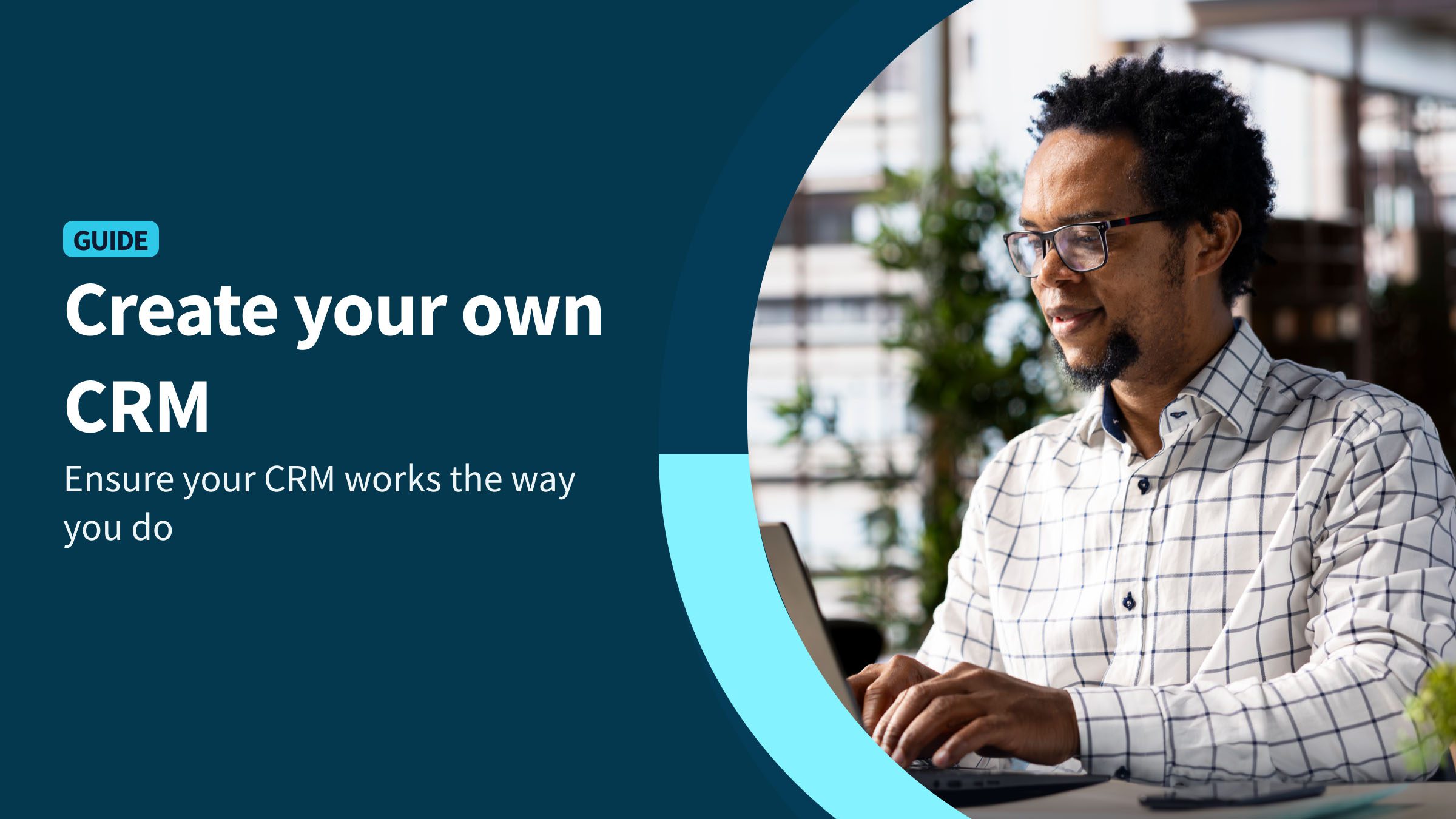At some point, businesses will begin to scale, and those mundane tasks that were handled with ease before start to become ever so burdensome on the operations of a business. When this point arrives, many business leaders will ask themselves: Should I invest in software for customer relationship management? And will an off-the-shelf CRM work, or is it better if I create my own? 🎨
A custom CRM can be incredibly powerful, but it can be costly, particularly if not done correctly. So, is building your own CRM a good idea, and do you need to be an expert in software development as well?
Here at Method CRM, we’ve been supporting QuickBooks-based businesses since 2010. Method is loved by business owners in the manufacturing sector for its two-way QuickBooks sync, customization services, and end-to-end sales automation. In this article, we’ll explore when it makes sense to build your own CRM, and why many teams choose a flexible platform like Method. ✨
Table of Contents
Why build a custom CRM? 🤔
Most businesses will naturally start with an off-the-shelf CRM, particularly one with a solid and easy-to-use UX, so that they don’t have to dive too deeply into the technical aspects at first. Off-the-shelf CRM features will work wonderfully at first, but eventually the team using it may begin to notice some limitations.
Limitations of off-the-shelf CRM software
| Limitation | How It Shows Up Day to Day |
|---|---|
| Rigid workflows | Sales, salesforce, service, and project stages don’t match your real process, so reps track extra steps in spreadsheets or notebooks. |
| Constrained data model | Critical details (job sites, equipment, custom pricing rules) end up crammed into generic fields. |
| Limited integrations | Accounting, operations, and CRM don’t fully talk to each other, leading to double entry and out-of-date records. |
| Paywalls for key features | Advanced automation, roles, or reports often sit behind expensive enterprise tiers. |
Benefits of a custom CRM
There are some very solid benefits to building a custom CRM, as delineated below.
- Workflow fit. Your stages, tasks, and notifications mirror how work actually moves from interest to invoice to repeat business.
- Flexibility over time. As you add services, locations, or team members, you can adjust fields, forms, and automations without changing platforms.
- Deeper integrations. A custom CRM can hook into your accounting, scheduling, inventory, or project tools so data flows both ways instead of being manually copied.
- Better reporting. Because the data model matches your reality, dashboards finally answer the questions you care about: job profitability, pipeline health, time to cash, and customer lifetime value.
When a custom CRM is worth it
Creating your own CRM solution is rarely the first step for a brand-new business, or at least one that operates in a newer, more efficient capacity than before.
You’ve outgrown generic tools, your team runs on workarounds, and you’re losing visibility into performance because your systems no longer reflect how you actually sell and deliver.
Typical triggers include complex sales cycles, industry-specific requirements, multi-location operations, or tight coordination between different entities like field teams and accounting. For example, a franchise network like Mobility City struggled when each of its 50+ locations used different systems and paper trails for sales, service, and rentals, so leadership introduced a unified, customized CRM that replaced disconnected processes and manual notes with centralized workflows — making operations consistent, faster, and easier to scale.
A “custom CRM” doesn’t have to mean hiring developers and starting from scratch. Many businesses take a build-with approach using a customizable platform like Method. You get a proven CRM core, deep QuickBooks integration, and prebuilt apps, then tailor screens, fields, and workflows to fit your process.
You can learn more about Method’s approach to custom CRM here: custom CRM software for QuickBooks.
Key considerations before you start 💭
Before you decide to create your own CRM, it helps to zoom out from “features” and think in terms of business outcomes. What do you actually want this system to do for you?
Define your goals and CRM objectives
Start by naming the problems you want the CRM to solve. Is it pipeline visibility, forecasting, or both? For instance, a roofing contractor may discover that most delays come from missed follow-ups and unclear job status, which turns “better pipeline visibility” into a clear priority.
Coordinate and map stakeholders and workflows
How does workflow move through your business, and who is involved? How is communication done between major stakeholders in the operation? For example, a residential HVAC company may involve sales, dispatch, field techs, and accounting in a single job, and each handoff needs clear steps so nothing gets lost.
Decide on your scope
Keep your first version focused, launch it with real users, and expand once you know what actually works. For example, a small plastics manufacturer might launch a Minimum Viable Product (MVP) that handles quotes, work orders, and basic production tracking so the floor team can start using it right away. Once that foundation holds up, they can layer in capacity planning or quality checks as the operation grows.
Budget, resources, and timeline
Building a custom CRM involves far more than writing software; it requires planning, design, configuration, testing, user training, and ongoing maintenance. Most teams underestimate the time and technical expertise needed, and end up spending time on a half-baked program that actually cuts efficiency.
A platform like Method removes much of that burden. You get a ready-made CRM with QuickBooks sync, then customize it without managing developers or infrastructure.
Step-by-step guide to creating your own CRM 📖
Once you’ve clarified why you want to create your own CRM and who it will serve, you can move into design and implementation. The steps below apply whether you’re coding from scratch, using low-code tools, or configuring a customizable platform like Method in your back end.
Step 1: Requirements and planning
Start by defining the fundamental capabilities that your CRM needs to support. In the manufacturing world, many times it will look like this.
| Component | What It Covers |
|---|---|
| Contact & account management | Companies, people, sites, and related records in one place. |
| Lead & opportunity tracking | Pipelines, stages, estimated values, and next steps. |
| Activities & follow-ups | Calls, emails, meetings, tasks, reminders, and assignments. |
| Quoting & proposals | Estimates, approvals, and handoff to jobs or projects. |
| Automation | Emails, task creation, status changes, and notifications triggered by events. |
| Reporting | Dashboards that show pipeline health, performance, and trends. |
With Method, many of these pieces are available through packs like Sales Pipeline, Contact Management, Time Tracking, and Proposals. You can start with these and then customize screens, fields, and logic instead of inventing everything from scratch.
Step 2: Information architecture and data model
Next, design how the data will be structured. That means deciding which “objects” you need (such as customers, contacts, jobs, quotes, invoices) and how they relate to each other.
What you track
Accounts, contacts, deals, jobs, tickets, projects, invoices.
How they connect
One account → many contacts, one deal → many activities, one job → many invoices.
What you store
Custom fields for industries, service types, locations, pricing tiers, equipment, or contracts.
Using Method’s customization services, you can add new tables, relate them to existing ones, and design screens so the right information is front and center for each team.
Step 3: Choose your build approach
There are several ways to create your own CRM, each with different trade-offs in flexibility, cost, and time to value.
Full custom build.
✅ Maximum control.
⚠️ High cost, long timeline, ongoing dev maintenance.
Visual builder with code options.
✅ Faster than raw code.
⚠️ Still requires technical skills and integration work.
Templates + drag-and-drop.
✅ Accessible for non-developers.
⚠️ Limited depth for complex workflows.
Customizable CRM for QuickBooks users.
✅ Prebuilt CRM + deep customization + two-way QuickBooks sync.
⚠️ Best suited to businesses ready to invest in process design.
For many small and mid-sized companies, building on top of Method strikes the right balance between flexibility and speed.
Step 4: Design the interface and user experience
Even the most powerful CRM will fail if no one can use it. Design screens around real daily workflows: what a sales rep needs to see when calling a lead, what a dispatcher needs when scheduling a job, what management needs on a pipeline review call.
In Method, you can tailor layouts by role, simplifying views for some users and surfacing advanced detail for others. That keeps adoption high and training time low; your sales team will appreciate it.
Step 5: Integrations and automation
This is where your existing CRM stops being a standalone database and becomes the hub of your business. Common integrations include email, calendars, marketing tools, project management, and, critically for many businesses, accounting.
If your CRM and accounting system don’t stay in sync, you’ll always be fighting duplicate records and outdated data. Method’s real-time, two-way QuickBooks sync keeps customers, items, estimates, and invoices aligned without manual re-entry.
Beyond integrations, you can set up workflow based follow ups, reminders, approvals, and email templates using Method Packs like Sales Pipeline, Time Tracking, and Proposals. For more advanced automations like routing and event triggered messages, Method can be configured with you so it matches your process.
Step 6: Dashboards and reporting
Once your CRM is capturing the right data, you can surface it through dashboards tailored to each role. A sales manager might care about pipeline coverage and win rates, while operations may focus on job backlog and on-time completion.
| Dashboard | Key Questions It Answers |
|---|---|
| Sales pipeline | What’s in each stage, what’s at risk, and what’s likely to close this month? |
| Account health | Which customers are growing, stagnant, or at risk based on activity and revenue? |
| Operations & jobs | Which jobs are in progress, delayed, or waiting on approvals or materials? |
| Cash and invoicing | Which invoices are outstanding, and how quickly are jobs moving to billing? |
Because Method pulls data from both CRM records and QuickBooks, you can build a more accurate picture of performance without stitching together reports from multiple systems.
Step 7: Testing, migration, and launch
Before rolling your new CRM out to everyone, test it with a smaller group of users. Import a subset of data, run live deals through the system, and document what works and what doesn’t. Use those findings to refine fields, views, and automations.
Then plan a phased rollout with training sessions, quick reference guides, and a clear process for capturing feedback. Method’s team can support you during this stage with guided onboarding and configuration adjustments.
Common pitfalls and how to avoid them ⚠️
Even with a solid plan, custom CRM projects can go off track. Most problems fall into a handful of predictable patterns.
Common pitfalls when you create your own CRM
- Scope creep: Trying to build every possible feature in version one leads to long delays and frustrated users. An MVP approach keeps momentum.
- Poor adoption: If the CRM feels slower than email or Google sheets, people will avoid it. Involve end users in design and prioritize ease of use.
- Underestimating maintenance: Custom code and home-grown integrations need ongoing care. Using a managed platform like Method reduces this burden.
- Ignoring integrations: A CRM that doesn’t connect to your accounting, scheduling, or marketing tools quickly becomes another silo.
- Weak data hygiene: Without clear rules for data entry, ownership, and cleanup, even the best system will fill up with inconsistent records.
Decision framework: Build vs buy vs build-with ⚖️
By this point, you might be weighing three options: keep your current CRM, build a completely custom system, or create the best CRM on top of a platform like Method.
When to buy an off-the-shelf CRM
An off-the-shelf CRM is usually the right choice if your team is small, your workflows are relatively standard, and you need to get up and running quickly with minimal upfront cost. Many businesses start here to prove out basic processes before investing in deeper customization.
When to build a custom CRM from scratch
A fully bespoke build tends to make sense for organizations with in-house development teams, highly specialized requirements, and the appetite to own long-term maintenance. This can include complex enterprise environments or software companies embedding CRM into their own product. Remember, an important part of this is for the customer. A good CRM can help you track customer experience, customer behavior and offer maximum customer support.
The middle path: Build with Method
For many SMBs, the sweet spot is a customizable CRM platform that provides a robust foundation and then adapts to your business.
Method offers:
- A proven CRM core. Contacts, pipelines, and quoting are available out of the gate. Add packs like Sales Transactions, Field Services, and Portal Access as needed.
- Deep QuickBooks integration. Two-way sync with QuickBooks Online, Desktop, and Enterprise so your front- and back-office stay aligned with maximum data security.
- Customization Services. Extend Method with custom tables, fields, screens, and workflows, built with you by Method’s customization team.
- Industry-specific flexibility. Method is widely used in field services, manufacturing, wholesale, construction, and professional services, where workflows rarely fit generic CRMs.
Maintenance, scalability, and future-proofing 👩🏻💻
Creating your own CRM is not a one-and-done project. The real value appears when you treat it as a living system that grows along with your business.
Ready-to-use functionality.
Contact management, pipelines and estimates, work orders, and customer portals are available out of the box so teams can get started quickly.
Two-way sync that keeps data aligned.
Syncs customer data, items, estimates, invoices, and payments across QuickBooks Online, Desktop, and Enterprise.
Adapt screens and workflows without coding.
Adapt screens and workflows to your processes, with Method’s team designing and extending the system alongside you.
Built for businesses that don’t fit generic CRMs.
Used across field services, manufacturing, wholesale, construction, and professional services.
For many businesses, this “build-with” model delivers the flexibility of a custom CRM without the cost and maintenance burden of building one from scratch.
Your CRM: Built for success 🚀
A CRM is designed to help your business processes run more efficiently, and building your own custom CRM system is about creating a better way to run your business that mirrors the inner workings of the entire operation. Think of building your CRM the same way you build a business; find the problems, find the solutions, and streamline everything to be as efficient as possible.
If you want a custom CRM solution that already syncs with QuickBooks and adapts to your processes without the cost of a full custom build, Method’s team can help you map a path to a system that truly fits. Try Method for free today. 📈
Frequently asked questions
How much does it cost to build a custom CRM?
CRM development costs vary widely based on complexity and your business needs. A fully custom CRM system built by developers can run into the tens or hundreds of thousands of dollars when you factor in design, development, testing, and ongoing maintenance. Using a customizable platform like Method spreads costs over subscription and implementation, reducing upfront investment while still giving you extensive flexibility.
How long does it take to build a CRM system?
A simple MVP CRM using a configurable platform might be live in a few weeks, while a complex, fully bespoke system can take many months. The biggest timeline drivers are the clarity of your requirements and how many people are involved to achieve customer satisfaction.






